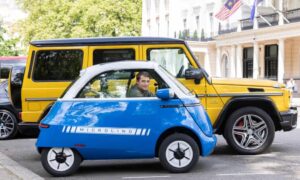
Driving through central London in a tiny Microlino electric car, barely visible between the hulking SUVs, it’s surprising to be the focus of so much attention. “Yes, Lego car!” shouts a scaffolder.
Made by Micro, the family-owned Swiss company behind the mini-micro kick scooters, and modelled on the bubble cars that had a brief heyday in the 1950s, the two-seater is only 2.5 metres long – marginally smaller than a Smart car. The most unusual feature is its one and only door (there is also a rear hatch for accessing the boot), which is at the front. The windscreen and bonnet swing open to let you in.
The Microlino goes on sale in the UK this month, in the face of a trend that is pushing the car industry in the opposite direction. Despite global heating, and the warnings of environmental scientists, the demand for ever larger cars just keeps growing.
Nearly half of global car sales were sports utility vehicles (SUVs) in 2023, according to the International Energy Agency (IEA), a respected forecaster. The definition of SUVs can be vague (usually something to do with a higher seating position and off-road styling), but the IEA this week said “the shift towards ever larger and heavier cars” is the “defining automobile trend of the early 21st century”.
Tiny cars are still a rarity, and the Microlino is enough to cause a stir. Uncountable people double take, wave, laugh and take pictures. Cyclists lean over to chat at traffic lights; a bus driver delays his passengers a few seconds to give a double thumbs up; a taxi driver suggests it could help this reporter’s romantic life.
Squeezing into a tiny space between a Bentley and a Land Rover Defender, the Microlino parks face-out under the watchful gaze of a bystander who turns out to be the owner of both luxury cars. This is in the posh London district that gave its name to the “Chelsea tractor”, where the four-wheel drive has become standard issue even if the residents rarely need off-road vehicles to make it to the shops and back.
The reach of the SUV now goes far beyond Chelsea, however. David Bailey, a professor of business economics at the University of Birmingham, said different pressures have contributed towards bigger cars. Customer demand for the space and a commanding seating position is part of it. Regulation is another: airbags and emissions control systems (such as AdBlue for diesels) add a larger percentage to costs in smaller cars.
